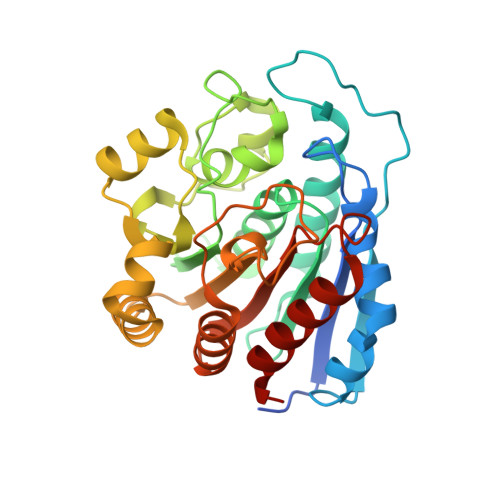Structural insights into Entamoeba histolytica arginase and structure-based identification of novel non-amino acid based inhibitors as potential antiamoebic molecules.
Malik, A., Dalal, V., Ankri, S., Tomar, S.(2019) FEBS J 286: 4135-4155
- PubMed: 31199070
- DOI: https://doi.org/10.1111/febs.14960
- Primary Citation of Related Structures:
5ZEE, 5ZEF, 5ZEH - PubMed Abstract:
Arginase, the binuclear metalloenzyme, is a potential target for therapeutic intervention in protozoan infections. Entamoeba histolytica infection causes amebiasis which is the second most common cause of protozoan-related human deaths after malaria. Here, we report the crystal structure of E. histolytica arginase (EhArg) in complex with two known inhibitors N ω -hydroxy-l-arginine (l-NOHA) and l-norvaline, and its product l-ornithine at 1.7, 2.0, and 2.4 Å, respectively. Structural and comparative analysis of EhArg-inhibitor complexes with human arginase revealed that despite only 33% sequence identity, the structural determinants of inhibitor recognition and binding are highly conserved in arginases with variation in oligomerization motifs. Knowledge regarding the spatial organization of residues making molecular contacts with inhibitory compounds enabled in the identification of four novel non-amino acid inhibitors, namely irinotecan, argatroban, cortisone acetate, and sorafenib. In vitro testing of the in silico-identified inhibitors using purified enzyme proved that irinotecan, argatroban, cortisone acetate, and sorafenib inhibit EhArg with IC 50 value (mm) of 1.99, 2.40, 0.91, and 2.75, respectively, as compared to the known inhibitors l-NOHA and l-norvaline with IC 50 value (mm) of 1.57 and 17.9, respectively. The identification of structure-based non-amino acid inhibitory molecules against arginase will be constructive in design and discovery of novel chemical modulators for treating amebiasis by directed therapeutics.
- Department of Biotechnology, Indian Institute of Technology Roorkee, India.
Organizational Affiliation:



















